Casimiroa, White sapote
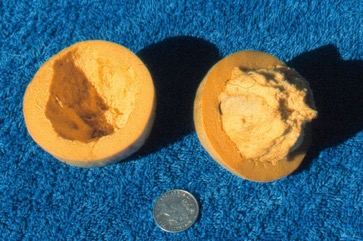
It is a subtropical tree. It is not suited to the coastal tropics nor the desert regions. It grows in the tropical highlands above 600 m. They tolerate a range of soil types. They need well drained soil. They show some frost, drought and salt tolerance. But trees fruit better if well watered. Sites protected from wind are best. They prefer a pH between 5.5 and 7.5. In Central America trees grow up to 2,500 m altitude. Deep, acid, sandy soils rich in compost are best. In Hobart Botanical gardens. It suits hardiness zones 10-11.
Also known as:
Cochitzapotl, Masuku, Matasano, Mexican apple, Pohon sapota putih, Tha-gyar-tee, Zapote, Zapote blanco
Synonyms
- Casimiroa sapota Oerst.
Edible Portion
- Fruit, Seeds, Nuts
Where does Casimiroa grow?
Found in: Africa, Asia, Australia, Bahamas, Belize, Brazil, Central America, Cook Islands, Costa Rica, Cuba, Dominican Republic, East Africa, El Salvador, Guatemala, Haiti, Hawaii, Hispaniola, Honduras, India, Indochina, Indonesia, Israel, Kenya, Malawi, Mediterranean, Mexico, Myanmar, New Zealand, Nicaragua, North Africa, North America, Pacific, Panama, Philippines, Puerto Rico, SE Asia, South Africa, South America, Spain, Tasmania, Tuvalu, United States, Venezuela, West Indies, Zimbabwe
Notes: There are 5-6 Casimiroa species.
Status: It is a cultivated food plant. Only recently introduced to Papua New Guinea. It should be planted in mid altitudinal zones.
Growing Casimiroa, White sapote
Cultivation: Plants do not grow true to type from seed. They can be grafted or budded. Air layering can be used. Seed need to be cleaned and planted fresh. A spacing between 4 and 8 m is recommended. Plants establish easily and grow quickly. Picking out the terminal bud can increase branching. Frequent light pruning is suggested to increase the number of fruiting arms but pruning should not be too heavy.
Edible Uses: The fruit is mainly eaten raw after removing the skin. They can be used in drinks. They are not suitable for cooking. They can be dried, frozen, served with cream and sugar or used in ice cream, milk shakes and salads. The seed can be eaten when fully dry and roasted. CAUTION The seeds are reported to be poisonous raw.
Production: Trees from seeds take 10 years to bear. Grafted or budded trees bear after 3-4 years. It takes 6-9 months from flowering to mature fruit. Fruit are picked when colour changes occur and ripened off the tree. They can be stored at 5°C for 3-6 weeks. Adding potash prior to fruiting and nitrogen prior to vegetative regrowth is suggested. Fruit yields are high. A large tree can produce a ton of fruit in one year. Fruit do not handle easily without damage.
Nutrition Info
per 100g edible portion| Edible Part | Energy (kcal) | Protein (g) | Iron (mg) | Vitamin A (ug) | Vitamin c (mg) | Zinc (mg) | % Water |
|---|---|---|---|---|---|---|---|
| Fruit | 65 | 1.4 | 0.3 | 53 | 28 | - | 78.3 |
| Seed | - | - | - | - | - | - |
Casimiroa, White sapote Photos

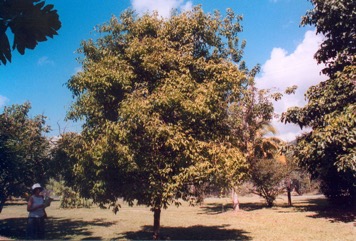
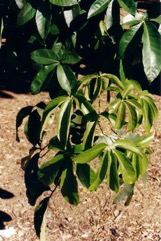
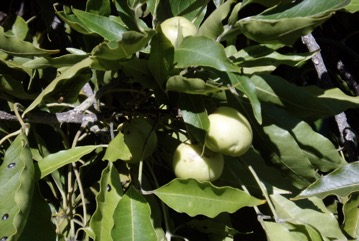
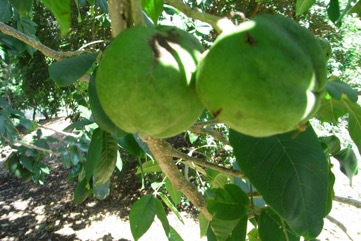
References
Altschul, S.V.R., 1973, Drugs and Foods from Little-known Plants. Notes in Harvard University Herbaria. Harvard Univ. Press. Massachusetts. no. 1915
Ambasta S.P. (Ed.), 2000, The Useful Plants of India. CSIR India. p 109
Arora, R. K., 2014, Diversity in Underutilized Plant Species - An Asia-Pacific Perspective. Bioversity International. p 62
Barwick, M., 2004, Tropical and Subtropical Trees. A Worldwide Encyclopedic Guide. Thames and Hudson p 91
Bircher, A. G. & Bircher, W. H., 2000, Encyclopedia of Fruit Trees and Edible Flowering Plants in Egypt and the Subtropics. AUC Press. p 88
Caballero, J. N., & Mapes, C. S., 1985, Gathering and Subsistence Patterns among the P'urhepecha Indians of Mexico. J. Ethnol. 5(1): 31-47
Chizmar Fernandez, C., et al, 2009, Plantas comestibles de Centroamerica. Instituto de Biodiversidad, Costa Rica. p 281
Casas, A., et al, 1996, Plant Management Among the Nahua and the Mixtec in the Balsas River Basin, Mexico: An Ethnobotanical Approach to the Study of Plant Domestication. Human Ecology, Vol. 24, No. 4 pp. 455-478
Coronel, R.E., 1982, Fruit Collections in the Philippines. IBPGR Newsletter p 6
Cruz, I. M., et al, 2015, Edible fruits and seeds in the State of Mexico. Revista Mexicana de Ciencias Agricolas. Vol. 6. Num. 2 pp 331-346
Cull, B.W., 1995, Fruit Growing in Warm Climates. Reed. p 155
Cundall, P., (ed.), 2004, Gardening Australia: flora: the gardener's bible. ABC Books. p 337
Darley, J.J., 1993, Know and Enjoy Tropical Fruit. P & S Publishers. p 25
Dharani, N., 2002, Field Guide to common Trees & Shrubs of East Africa. Struik. p 64
Facciola, S., 1998, Cornucopia 2: a Source Book of Edible Plants. Kampong Publications, p 213
FAO, 1988, Traditional Food Plants, FAO Food and Nutrition Paper 42. FAO Rome p 150
Gouldstone, S., 1983, Growing your own Food-bearing Plants in Australia. Macmillan p 84
Grandtner, M. M., 2008, World Dictionary of Trees. Wood and Forest Science Department. Laval University, Quebec, Qc Canada. (Internet database http://www.WDT.QC.ca)
Hedrick, U.P., 1919, (Ed.), Sturtevant's edible plants of the world. p 173
Hermandez Bermejo, J.E., and Leon, J. (Eds.), 1994, Neglected Crops. 1492 from a different perspective. FAO Plant Production and Protection Series No 26. FAO, Rome. p17
Hibbert, M., 2002, The Aussie Plant Finder 2002, Florilegium. p 61
Jardin, C., 1970, List of Foods Used In Africa, FAO Nutrition Information Document Series No 2.p 125
John, L., & Stevenson, V., 1979, The Complete Book of Fruit. Angus & Robertson p 101
Kiple, K.F. & Ornelas, K.C., (eds), 2000, The Cambridge World History of Food. CUP p 1880
Lazarides, M. & Hince, B., 1993, Handbook of Economic Plants of Australia, CSIRO. p 50
Lorenzi, H., Bacher, L., Lacerda, M. & Sartori, S., 2006, Brazilian Fruits & Cultivated Exotics. Sao Paulo, Instituto Plantarum de Estuados da Flora Ltda. p 526
Lyle, S., 2006, Discovering fruit and nuts. Land Links. p 112
Macmillan, H.F. (Revised Barlow, H.S., et al) 1991, Tropical Planting and Gardening. Sixth edition. Malayan Nature Society. Kuala Lumpur. p 313
Martin, F. W., et al, 1987, Perennial Edible Fruits of the Tropics. USDA Handbook 642 p 56
Miguel, E., et al, 1989, A checklist of the cultivated plants of Cuba. Kulturpflanze 37. 1989, 211-357
Morton,
Nov. veg. descr. 2:2, 9. 1825
Popenoe,
PROSEA (Plant Resources of South East Asia) handbook, Volume 2, 1991, Edible fruits and nuts.
Purseglove, J.W., 1968, Tropical Crops Dicotyledons, Longmans. p 493
Recher, P, 2001, Fruit Spirit Botanical Gardens Plant Index. www.nrg.com.au/~recher/ seedlist.html p 1
Segura, S., et al, 2018, The edible fruit species in Mexico. Genet Resour Crop Evol (2018) 65:1767–1793
Shin, T., et al, 2018, Traditional knowledge of wild edible plants with special emphasis on medicinal uses in Southern Shan State, Myanmar. Journal of Ethnobiology and Ethnomedicine (2018) 14:48
Solomon, C., 2001, Encyclopedia of Asian Food. New Holland. p 330
Staples, G.W. and Herbst, D.R., 2005, A tropical Garden Flora. Bishop Museum Press, Honolulu, Hawaii. p 492 (Drawing)
Sukarya, D. G., (Ed.) 2013, 3,500 Plant Species of the Botanic Gardens of Indonesia. LIPI p 180
Tankard, G., 1990, Tropical fruit. An Australian Guide to Growing and using exotic fruit. Viking p 36
Tate, D., 1999, Tropical Fruit. Archipelago Press. Singapore. p 44
TodaFruta.com.br
USDA, ARS, National Genetic Resources Program. Germplasm Resources Information Network - (GRIN). [Online Database] National Germplasm Resources Laboratory, Beltsville, Maryland. Available: www.ars-grin.gov/cgi-bin/npgs/html/econ.pl (10 April 2000)
World Checklist of Useful Plant Species 2020. Royal Botanic Gardens, Kew
www.worldagroforestrycentre.org/sea/products/afdbases/af